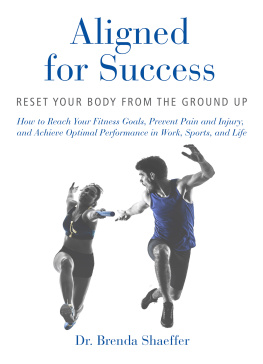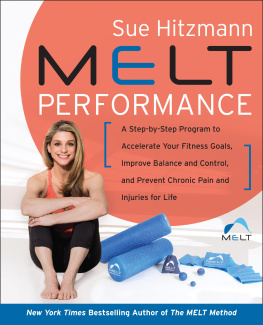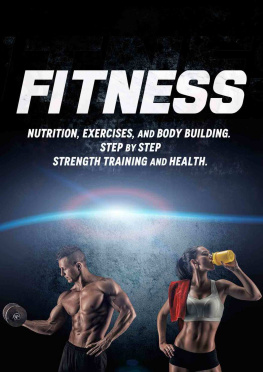

Contents
Foreword
As an amateur national and international Olympic athlete and coach, achieving and maintaining a high level of physical fitness is, and always has been, one of the most important parts of my life and career. Over time, I started to have pain in my back from years of training and competition, and it became severe enough to affect nearly all aspects of my life. Eventually, the pain shut me down. MRIs of my back verified why I had intractable pain and could no longer function at home or work, or even perform mundane daily tasks, such as driving, without pain and leg numbness.
At that point, I sought the expertise of Dr. Brenda Shaeffer, who evaluated, assessed, and realigned my body. She taught me how to maintain these changes and apply new ways to move in all parts of my life to protect my injured area. She figured out a blueprint to help me understand why my body hurt, how I was going to heal, be able to run again, and move forward. Although medications and injections temporarily reduced my severe pain, Dr. Shaeffer taught me the changes I needed to make to my physical alignment to stay active. She instantly improved how I understood my injuries, showed me how to listen to my bodys cues and, as a result, I resumed all my activities, modifying them to match the realities of how to avoid further problems. In fact, I continue to lead my normal, physically active lifestyle. I have returned to running three to four times per week and using the elliptical and other machines the rest of the week. I am coaching, and remain very active in my three childrens lives without pain as a regular presence. I have learned through Dr. Shaeffer how to translate the pain I feel on occasion, and what tools to use to stop it before it builds. My back MRI still shows the consequences of my very active life and athletic career, but I no longer have to be fearful of what this means for my future. I can move forward in my life.
In her new book Aligned for Success: Reset Your Body from the Ground Up , Dr. Shaeffer combines her years of experience, training, and education with the latest medical research to provide simple yet effesctive tools we all need to feel better, grow stronger, and help prevent pain or injuries. She reveals her scientifically sound method of Thinking in Threes and teaches us how to rethink, recognize, and reset our bodies. Dr. Shaeffer quickly and safely taught me the necessary changes I needed to make in my physical alignment, and how to maintain it to become pain free without any invasive surgeries!
I now have the confidence to continue with all the physical activities in my profession, as well as my daily health activities. I am forever grateful!
Carin Gabarra Head Soccer Coach, US Naval Academy 1991 US Soccer World Champion 1996 US Olympic Gold Medalist
Preface
Aligned for Success is intended for anyone who is ready to stop and rethink how to use their body. Within this book you will recognize and apply new facts about your body, learn a few basic skills, and discover what tools to use and when to use them. You will regain confidence in making decisions about how to reach your optimal health and well-being. You will be able to take immediate action in resetting your body to move, rest, recover, and repair as it was designed to do. Learn how to make the next right decision, not just the best, when solving your health issues.
Aligned for Success presents a predictive, proactive, and restorative system to eliminate the guesswork in finding that balance needed to restore your bodys abilities. By learning and becoming confident in the three-step method: rethink, recognize, and reset, you will be able to make improvements at any age or stage of your life. Reset freedom of motion by fundamentally understanding natural movement and how your body is designed to support, transport, and restore itself. Take the right three steps in decision-making every time you have pain, an injury, or hit a performance plateau in sports or work. The three-step method is a tool which can help prevent and reduce the effects of the most preventable issues facing the healthcare community and population today. Learning how to use the three-step method helps a person become a skilled operator of their own body, and to attain, maintain, and control optimal performance in health and well-being for life.
Introduction
In 1978, I had a front row seat at the birth of the fitness industry as it is interpreted in the United States today. In December of that year, as a new physical therapist, I attended the first research educational fitness conference, where scientists corroborated new evidence to develop guidelines for adults to move and stay healthy. America had become increasingly sedentary and mechanized, with more cars, less community, more processed foods, and with the busied lifestyle in full swing. Physical therapists had been becoming more involved with the concepts of whole-body health, not just joint range of motion, modalities, and/or strengthening as a remedy. We began integrating fitness into our therapies, but no real guidelines for proper mechanics or safety had been concretely established. During the conference, I had the pleasure to talk with Jesse Owens, who was also the keynote speaker, in a room full of enthusiastic physical therapists, exercise scientists, and physicians, all interested in trying to make determinations on how to keep American adults physically fit. Mr. Owenss thoughts on this topic (after he put out his cigarette in an ashtray at the speakers podium) were that we should remember to be respectful to our bodies; we should listen to our bodies and realize that by the time we are forty-five years old, we have lived half our lives, and that we should be grateful for that, and realize our abilities will naturally decline and we must alter our expectations to match this reality. In addition, he felt that injury prevention and determining fitness guidelines would not be needed if we applied common health practices: eating well, exercising, resting, and finding the balance within all applications. This was also the advice in the formative years for fundamental exercise rules which was published in a primer for primary though college-aged students in 1884 (Smith, 1884 [See for full citations]). We did not listen to the advice of Mr. Owens or the wise observances of the physicians from nearly one hundred years prior. At the time of the conference, the fitness industry was focused on cardio because of the sedentary lifestyles that abounded. Weight loss was the primary goal in fitness programs. After that conference, the development of fitness and intentional health concepts and the consequences we are now living with today included high-impact aerobics, lots of reps with muscle work based largely on the single muscle-building model from earlier fitness muscle competitions, stretching, which was thought to be good if you had pain to lengthen the muscles, and dramatic changes in food source engineering and processing. This approach, over the next fifteen years, led to a rapidly increasing rate of overuse syndromes from too much joint impact without adequate rest or recovery, massive numbers of osteoarthritis (wear and tear on joints loaded incorrectly over and over), obesity levels never before seen, and pain needs managed with drugs at an epidemic level.
To put it plainly, I also did not find the balance I needed. I had a large outpatient orthopedic physical therapy practice I owned with another PT with five different locations at one point, and had gotten caught up in the insurance-driven game of PT, dictated by the numbers. Quantity not quality became the force and reality, even when it was not the intent. Research was beginning to become clearer in how the body works, especially with the most common issuespain in the low back, neck, knee, and shoulder not caused by an accident or obvious incidentI would see in the orthopedic setting. Physical therapy at that time was outdated, and included performing exercises in a specific area where pain presented itself, providing manual therapy, stretching everything and strengthening the core, hoping the patient would just reach their goals. But that approach was missing key elements. The words closed chain, kinetic chain, and functional were very new age at that point. I continued to strive to keep up with the research and apply the findings to my patients issues. Spine stabilization and core became very popular in the 1980s but continued to focus on the mid-abdomen and largely ignore the whole body, while Pilates and yoga were becoming more popular across the country. Something was missing. Connecting the gym and exercise class model to real life and natural movements, and properly loading the body was fundamentally missing. I let myself become a victim of my own profession, and previous injuries caught up with me. A turning point for me came in 2005, when the newest and most definitive research on the brain regarding pain and biomechanics was becoming clearer. That information came at a time I personally needed it the most. In about 1972, I had been training as a highly competitive gymnast, and during a meet fell onto my bent neck from about nine feet high when I missed catching the high bar. I landed on a concrete floor covered by a canvas cotton batting mat, injuring my spine at two levels, eventually creating a forty-five-degree scoliosis over the years from poor treatment.
Next page






